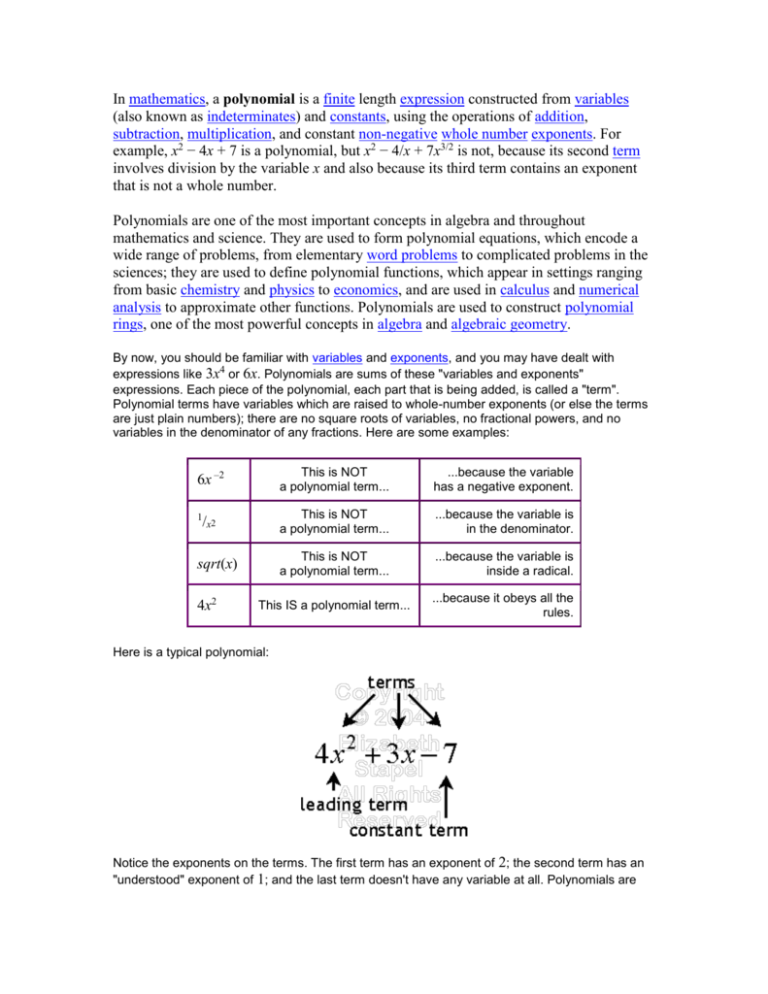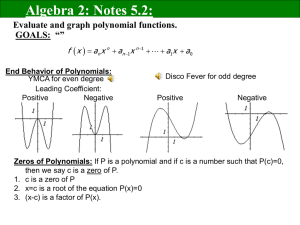
In mathematics, a polynomial is a finite length expression constructed from variables
(also known as indeterminates) and constants, using the operations of addition,
subtraction, multiplication, and constant non-negative whole number exponents. For
example, x2 − 4x + 7 is a polynomial, but x2 − 4/x + 7x3/2 is not, because its second term
involves division by the variable x and also because its third term contains an exponent
that is not a whole number.
Polynomials are one of the most important concepts in algebra and throughout
mathematics and science. They are used to form polynomial equations, which encode a
wide range of problems, from elementary word problems to complicated problems in the
sciences; they are used to define polynomial functions, which appear in settings ranging
from basic chemistry and physics to economics, and are used in calculus and numerical
analysis to approximate other functions. Polynomials are used to construct polynomial
rings, one of the most powerful concepts in algebra and algebraic geometry.
By now, you should be familiar with variables and exponents, and you may have dealt with
expressions like 3x4 or 6x. Polynomials are sums of these "variables and exponents"
expressions. Each piece of the polynomial, each part that is being added, is called a "term".
Polynomial terms have variables which are raised to whole-number exponents (or else the terms
are just plain numbers); there are no square roots of variables, no fractional powers, and no
variables in the denominator of any fractions. Here are some examples:
6x –2
This is NOT
a polynomial term...
...because the variable
has a negative exponent.
1
This is NOT
a polynomial term...
...because the variable is
in the denominator.
This is NOT
a polynomial term...
...because the variable is
inside a radical.
This IS a polynomial term...
...because it obeys all the
rules.
/x2
sqrt(x)
4x2
Here is a typical polynomial:
Notice the exponents on the terms. The first term has an exponent of 2; the second term has an
"understood" exponent of 1; and the last term doesn't have any variable at all. Polynomials are
usually written this way, with the terms written in "decreasing" order; that is, with the largest
exponent first, the next highest next, and so forth, until you get down to the plain old number.
Any term that doesn't have a variable in it is called a "constant" term because, no matter what
value you may put in for the variable x, that constant term will never change. In the picture above,
no matter what x might be, 7 will always be just 7.
The first term in the polynomial, when it is written in decreasing order, is also the term with the
biggest exponent, and is called the "leading term".
The exponent on a term tells you the "degree" of the term. For instance, the leading term in the
above polynomial is a "second-degree term" or "a term of degree two". The second term is a "first
degree" term. The degree of the leading term tells you the degree of the whole polynomial; the
polynomial above is a "second-degree polynomial". Here are a couple more examples:
Give the degree of the following polynomial:
2x5 – 5x3 – 10x + 9
This polynomial has four terms, including a fifth-degree term, a third-degree term, a firstdegree term, and a constant term.
This is a fifth-degree polynomial.
Give the degree of the following polynomial:
7x4 + 6x2 + x
This polynomial has three terms, including a fourth-degree term, a second-degree term,
and a first-degree term. There is no constant term.
This is a fourth-degree polynomial.
When a term contains both a number and a variable part, the number part is called the
"coefficient". The coefficient on the leading term is called the "leading" coefficient.
In the above example, the coefficient of the leading term is 4; the coefficient of the second term is
3; the constant term doesn't have a coefficient. Copyright © Elizabeth Stapel 2006-2008 All Rights Reserved
The "poly" in "polynomial" means "many". I suppose, technically, the term "polynomial" should
only refer to sums of many terms, but the term is used to refer to anything from one term to the
sum of a zillion terms. However, the shorter polynomials do have their own names:
a one-term polynomial, such as 2x or 4x2, may also be called a "monomial" ("mono"
meaning "one")
a two-term polynomial, such as 2x + y or x2 – 4, may also be called a "binomial" ("bi"
meaning "two")
a three-term polynomial, such as 2x + y + z or x4 + 4x2 – 4, may also be called a
"trinomial" ("tri" meaning "three")
I don't know if there are names for polynomials with a greater numbers of terms; I've never heard
of any names other than what I've listed.
Polynomials are also sometimes named for their degree:
a second-degree polynomial, such as 4x2, x2 – 9, or ax2 + bx + c, is also called a
"quadratic"
a third-degree polynomial, such as –6x3 or x3 – 27, is also called a "cubic"
a fourth-degree polynomial, such as x4 or 2x4 – 3x2 + 9, is sometimes called a "quartic"
a fifth-degree polynomial, such as 2x5 or x5 – 4x3 – x + 7, is sometimes called a "quintic"
There are names for some of the higher degrees, but I've never heard of any names being used
other than the ones I've listed.
By the way, yes, "quad" generally refers to "four", as when an ATV is referred to as a "quad bike".
For polynomials, however, the "quad" from "quadratic" is derived from the Latin for "making
square". As in, if you multiply length by width (of, say, a room) to find the area in "square" units,
the units will be raised to the second power. The area of a room that is 6 meters by 8 meters is 48
m2. So the "quad" refers to the four corners of a square, from the geometrical origins of parabolas
and early polynomials.
Evaluation
"Evaluating" a polynomial is the same as evaluating anything else: you plug in the given value of
x, and figure out what y is supposed to be. For instance:
Evaluate 2x3
– x2 – 4x + 2 at x = –3
I need to plug in "–3" for the "x", remembering to be careful with my parentheses and the
negatives:
2(–3)3 – (–3)2 – 4(–3) + 2
= 2(–27) – (9) + 12 + 2
= –54 – 9 + 14
= –63 + 14
= –49
Always remember to be careful with the minus signs!
Overview
A polynomial is either zero, or can be written as the sum of one or more non-zero terms.
The number of terms is finite. These terms consist of a constant (called the coefficient of
the term) multiplied by zero or more variables (which are usually represented by letters).
Each variable may have an exponent that is a non-negative integer (also known as a
natural number). The exponent on a variable in a term is equal to the degree of that
variable in that term. Since x = x1, the degree of a variable without a written exponent is
one. A term with no variables is called a constant term, or just a constant. The degree of a
constant term is 0. The coefficient of a term may be any number, including fractions,
irrational numbers, negative numbers, and complex numbers.
For example,
is a term. The coefficient is –5, the variables are x and y, the degree of x is two, and the
degree of y is one.
The degree of the entire term is the sum of the degrees of each variable in it. In the
example above, the degree is 2 + 1 = 3.
A polynomial is a sum of terms. For example, the following is a polynomial:
It consists of three terms: the first is degree two, the second is degree one, and the third is
degree zero. Here "− 5x" stands for "+ (−5)x", so the coefficient of the middle term is −5.
When a polynomial in one variable is arranged in the traditional order, the terms of
higher degree come before the terms of lower degree. In the first term above, the
coefficient is 3, the variable is x, and the exponent is 2. In the second term, the coefficient
is –5. The third term is a constant. The degree of a non-zero polynomial is the largest
degree of any one term. In this example, the polynomial has degree two.
[edit] Alternative forms
An expression that can be converted to polynomial form through a sequence of
applications of the commutative, associative, and distributive laws is usually considered
to be a polynomial. For instance,
is a polynomial because it can be worked out to x3 + 3x2 + 3x + 1. Similarly,
is considered a valid term in a polynomial, even though it involves a division, because it
is equivalent to
and is just a constant. The coefficient of this term is therefore .
For similar reasons, if complex coefficients are allowed, one may have a single term like
(2 + 3i)x3; even though it looks like it should be worked out to two terms, the complex
number 2+3i is in fact just a single coefficient in this case that happens to require a "+" to
be written down.
Division by an expression containing a variable is not generally allowed in
polynomials.[1] For example,
is not a polynomial because it includes division by a variable. Similarly,
is not a polynomial, because it has a variable exponent.
Since subtraction can be treated as addition of the additive opposite, and since
exponentiation to a constant positive whole number power can be treated as repeated
multiplication, polynomials can be constructed from constants and variables with just the
two operations addition and multiplication.
[edit] Polynomial functions
A polynomial function is a function defined by evaluating a polynomial. A function ƒ of
one argument is called a polynomial function if it satisfies
for all arguments x, where n is a nonnegative integer and a0, a1,a2, ..., an are constant
coefficients.
For example, the function ƒ, taking real numbers to real numbers, defined by
is a polynomial function of one argument. Polynomial functions of multiple arguments
can also be defined, using polynomials in multiple variables, as in
Polynomial functions are an important class of smooth functions.
[edit] Polynomial equations
A polynomial equation is an equation in which a polynomial is set equal to another
polynomial.
is a polynomial equation. In case of a polynomial equation the variable is considered an
unknown, and one seeks to find the possible values for which both members of the
equation evaluate to the same value (in general more than one solution may exist). A
polynomial equation is to be contrasted with a polynomial identity like (x + y)(x – y) =
x2–y2, where both members represent the same polynomial in different forms, and as a
consequence any evaluation of both members will give a valid equality.
[edit] Elementary properties of polynomials
1.
2.
3.
4.
A sum of polynomials is a polynomial.
A product of polynomials is a polynomial
The derivative of a polynomial function is a polynomial function
Any primitive or antiderivative of a polynomial function is a polynomial function
Polynomials serve to approximate other functions, such as sine, cosine, and exponential.
All polynomials have an expanded form, in which the distributive law has been used to
remove all brackets. All polynomials with real or complex coefficients also have a
factored form in which the polynomial is written as a product of linear complex
polynomials. For example, the polynomial
is the expanded form of the polynomial
,
which is written in factored form. Note that the constants in the linear polynomials (like 3 and +1 in the above example) may be complex numbers in certain cases, even if all
coefficients of the expanded form are real numbers. This is because the field of real
numbers is not algebraically closed; however, the fundamental theorem of algebra states
that the field of complex numbers is algebraically closed.
Every polynomial in one variable is equivalent to a polynomial with the form
This form is sometimes taken as the definition of a polynomial in one variable.
Evaluation of a polynomial consists of assigning a number to each variable and carrying
out the indicated multiplications and additions. Evaluation is sometimes performed more
efficiently using the Horner scheme
In elementary algebra, methods are given for solving all first degree and second degree
polynomial equations in one variable. In the case of polynomial equations, the variable is
often called an unknown. The number of solutions may not exceed the degree, and will
equal the degree when multiplicity of solutions and complex number solutions are
counted. This fact is called the fundamental theorem of algebra.
A system of polynomial equations is a set of equations in which a given variable must
take on the same value everywhere it appears in any of the equations. Systems of
equations are usually grouped with a single open brace on the left. In elementary algebra,
methods are given for solving a system of linear equations in several unknowns. To get a
unique solution, the number of equations should equal the number of unknowns. If there
are more unknowns than equations, the system is called underdetermined. If there are
more equations than unknowns, the system is called overdetermined. This important
subject is studied extensively in the area of mathematics known as linear algebra.
Overdetermined systems are common in practical applications. For example, one U.S.
mapping survey used computers to solve 2.5 million equations in 400,000 unknowns.[2]
[edit] More advanced examples of polynomials
This article may require cleanup to meet Wikipedia's quality standards.
Please improve this article if you can. (September 2008)
In linear algebra, the characteristic polynomial of a square matrix encodes several
important properties of the matrix.
In graph theory the chromatic polynomial of a graph encodes the different ways to vertex
color the graph using x colors.
In abstract algebra, one may define polynomials with coefficients in any ring.
In knot theory the Alexander polynomial, the Jones polynomial, and the HOMFLY
polynomial are important knot invariants.
[edit] History
Determining the roots of polynomials, or "solving algebraic equations", is among the
oldest problems in mathematics. However, the elegant and practical notation we use
today only developed beginning in the 15th century. Before that, equations are written
out in words. For example, an algebra problem from the Chinese Arithmetic in Nine
Sections, circa 200 BCE, begins "Three sheafs of good crop, two sheafs of mediocre
crop, and one sheaf of bad crop are sold for 29 dou." We would write 3x + 2y + z = 29.
[edit] Notation
Main article: History of mathematical notation
The earliest known use of the equal sign is in Robert Recorde's The Whetstone of Witte,
1557. The signs + for addition, − for subtraction, and the use of a letter for an unknown
appear in Michael Stifel's Arithemetica integra, 1544. René Descartes, in La géometrie,
1637, introduced the concept of the graph of a polynomial equation. He popularized the
use of letters from the beginning of the alphabet to denote constants and letters from the
end of the alphabet to denote variables, as can be seen above, in the general formula for a
polynomial in one variable, where the a 's denote constants and x denotes a variable.
Descartes introduced the use of superscripts to denote exponents as well.[3]
[edit] Solving polynomial equations
Every polynomial corresponds to a polynomial function, where f(x) is set equal to the
polynomial, and to a polynomial equation, where the polynomial is set equal to zero. The
solutions to the equation are called the roots of the polynomial and they are the zeroes of
the function and the x-intercepts of its graph. If x = a is a root of a polynomial, then (x −
a) is a factor of that polynomial.
Some polynomials, such as f(x) = x2 + 1, do not have any roots among the real numbers.
If, however, the set of allowed candidates is expanded to the complex numbers, every
(non-constant) polynomial has at least one distinct root; this follows from the
fundamental theorem of algebra.
There is a difference between approximating roots and finding exact roots. Formulas for
the roots of polynomials up to a degree of 2 have been known since ancient times (see
quadratic equation) and up to a degree of 4 since the 16th century (see Gerolamo
Cardano, Niccolo Fontana Tartaglia). But formulas for degree 5 eluded researchers. In
1824, Niels Henrik Abel proved the striking result that there can be no general formula
(involving only the arithmetical operations and radicals) for the roots of a polynomial of
degree 5 or greater in terms of its coefficients (see Abel-Ruffini theorem). This result
marked the start of Galois theory which engages in a detailed study of relationships
among roots of polynomials.
Numerically solving a polynomial equation in one unknown is easily done on a computer
by the Durand-Kerner method or by some other root-finding algorithm. The reduction of
equations in several unknowns to equations each in one unknown is discussed in the
article on the Buchberger's algorithm. The special case where all the polynomials are of
degree one is called a system of linear equations, for which a range of different solution
methods exist, including the classical gaussian elimination.
It has been shown by Richard Birkeland and Karl Meyr that the roots of any polynomial
may be expressed in terms of multivariate hypergeometric functions. Ferdinand von
Lindemann and Hiroshi Umemura showed that the roots may also be expressed in terms
of Siegel modular functions, generalizations of the theta functions that appear in the
theory of elliptic functions. These characterizations of the roots of arbitrary polynomials
are generalizations of the methods previously discovered to solve the quintic equation.
[edit] Graphs
A polynomial function in one real variable can be represented by a graph.
The graph of the zero polynomial
f(x) = 0
is the x-axis.
The graph of a degree 0 polynomial
f(x) = a0, where a0 ≠ 0,
is a horizontal line with y-intercept a0
The graph of a degree 1 polynomial (or linear function)
f(x) = a0 + a1x , where a1 ≠ 0,
is an oblique line with y-intercept a0 and slope a1.
The graph of a degree 2 polynomial
f(x) = a0 + a1x + a2x2, where a2 ≠ 0
is a parabola.
The graph of a degree 3 polynomial
f(x) = a0 + a1x + a2x2, + a3x3, where a3 ≠ 0
is a cubic curve.
The graph of any polynomial with degree 2 or greater
f(x) = a0 + a1x + a2x2 + ... + anxn , where an ≠ 0 and n ≥ 2
is a continuous non-linear curve.
Polynomial graphs are analyzed in calculus using intercepts, slopes, concavity, and end
behavior.
The illustrations below show graphs of polynomials.
Polynomial of degree 2:
f(x) = x2 - x - 2
= (x+1)(x-2)
Polynomial of degree 3:
f(x) = x3/4 + 3x2/4 - 3x/2 - 2
= 1/4 (x+4)(x+1)(x-2)
Polynomial of degree 4:
Polynomial of degree 5:
f(x) = 1/14 (x+4)(x+1)(x-1)(x-3) + 0.5 f(x) = 1/20 (x+4)(x+2)(x+1)(x-1)(x-3) + 2
Classifications
The most important classification of polynomials is based on the number of distinct
variables. A polynomial in one variable is called a univariate polynomial, a polynomial
in more than one variable is called a multivariate polynomial. These notions refer more
to the kind of polynomials one is generally working with than to individual polynomials;
for instance when working with univariate polynomials one does not exclude constant
polynomials (which may result for instance from the subtraction of non-constant
polynomials), although strictly speaking constant polynomials do not contain any
variables at all. It is possible to further classify multivariate polynomials as bivariate,
trivariate etc., according to the number of variables, but this is rarely done; it is more
common for instance to say simply "polynomials in x, y, and z". A (usually multivariate)
polynomial is called homogeneous of degree n if all its terms have degree n.
Univariate polynomials have many properties not shared by multivariate polynomials.
For instance, the terms of a univariate polynomial are completely ordered by their degree,
and it is conventional to always write them in order of decreasing degree. A univariate
polynomial in x of degree n then takes the general form
where
cn, cn-1, ..., c2, c1 and c0 are constants, the coefficients of this polynomial.
Here the term cnxn is called the leading term and its coefficient cn the leading
coefficient; if the leading coefficient is 1, the univariate polynomial is called monic.
Note that apart from the leading coefficient cn (which must be non-zero or else the
polynomial would not be of degree n) this general form allows for coefficients to be zero;
when this happens the corresponding term is zero and may be removed from the sum
without changing the polynomial. It is nevertheless common to refer to ci as the
coefficient of xi, even when ci happens to be 0, so that xi does not really occur in any
term; for instance one can speak of the constant term of the polynomial, meaning c0 even
if it should be zero.
Polynomials can similarly be classified by the kind of constant values allowed as
coefficients. One can work with polynomials with integral, rational, real or complex
coefficients, and in abstract algebra polynomials with many other types of coefficients
can be defined. Like for the previous classification, this is about the coefficients one is
generally working with; for instance when working with polynomials with complex
coefficients one includes polynomials whose coefficients happen to all be real, even
though such polynomials can also be considered to be a polynomials with real
coefficients.
Polynomials can further be classified by their degree and/or the number of non-zero
terms they contain.
Polynomials classified by degree
Degree
Name
Example
−∞
zero
0
0
(non-zero) constant
1
1
linear
x+1
2
quadratic
x2 + 1
3
cubic
x3 + 1
4
quartic (or biquadratic)
x4 + 1
5
quintic
x5 + 1
6
sextic or hexic
x6 + 1
7
septic or heptic
x7 + 1
8
octic
x8 + 1
9
nonic
x9 + 1
10
decic
x10 + 1
Usually, a polynomial of degree 4 or higher is referred to as a polynomial of degree n,
although the phrases quartic polynomial and quintic polynomial are also used. The names
for degrees higher than 5 are even less common. The names for the degrees may be
applied to the polynomial or to its terms. For example, a constant may refer to a zero
degree polynomial or to a zero degree term.
The polynomial 0, which may be considered to have no terms at all, is called the zero
polynomial. Unlike other constant polynomials, its degree is not zero. Rather the degree
of the zero polynomial is either left explicitly undefined, or defined to be negative (either
–1 or –∞).[4] The latter convention is important when defining Euclidean division of
polynomials.
Polynomials classified by number of non-zero terms
Number of non-zero terms
Name
Example
0
zero polynomial
0
1
monomial
x2
2
binomial
x2 + 1
3
trinomial
x2 + x + 1
Further, polynomials may be classified by the number of terms (using the minimal
number of terms, that is, not counting zero terms and combining like terms). The word
monomial can be ambiguous, used either to refer to a polynomial with just a single term,
as above, or to refer to the particular case of monic monomials, that is, having coefficient
1.[5]
Polynomials
A polynomial looks like this:
example of a polynomial
this one has 3 terms
It can be made of:
constants (like 3, -20, or ½)
variables (like x and y)
exponents (like the 2 in y2) but they can only be 0, 1, 2, 3, ... etc
That can be combined using:
+×
addition, subtraction and multiplication, ...
... but not division!
Those rules keeps polynomials simple, so they are easy to work with!
Polynomials or Not?
These are polynomials:
3x
x-2
3xyz + 3xy2z - 0.1xz - 200y + 0.5
And these are not polynomials
2/(x+2) is not, because dividing is not allowed
3xy-2 is not, because the exponent is "-2" (exponents can only be 0,1,2,...)
But this is allowed:
x/2 is allowed, because it is also (½)x (the constant is ½, or 0.5)
also 3x/8 for the same reason (the constant is 3/8, or 0.375)
Monomial, Binomial, Trinomial
There are special names for polynomials with 1, 2 or 3 terms:
How do you remember the names? Think cycles!
(There's also quadrinomial (4 terms) and quintinomial (5 terms), but
these are not often used)
Lots and Lots of Terms
Polynomials can have as many terms as needed, but not an infinite
number of terms.
What is Special About Polynomials?
Because of the strict definition, polynomials are easy to work with.
For example we know that:
If you add polynomials you get a polynomial
If you multiply polynomials you get a polynomial
So you can do lots of additions and multiplications, and still have a
polynomial as the result.
Degree
The degree of a polynomial with only one variable is the largest
exponent of that variable.
Example:
The Degree is 3 (the largest exponent of
x)










